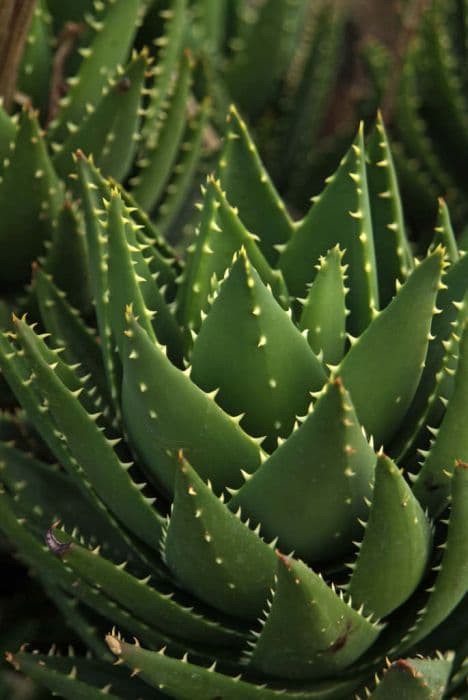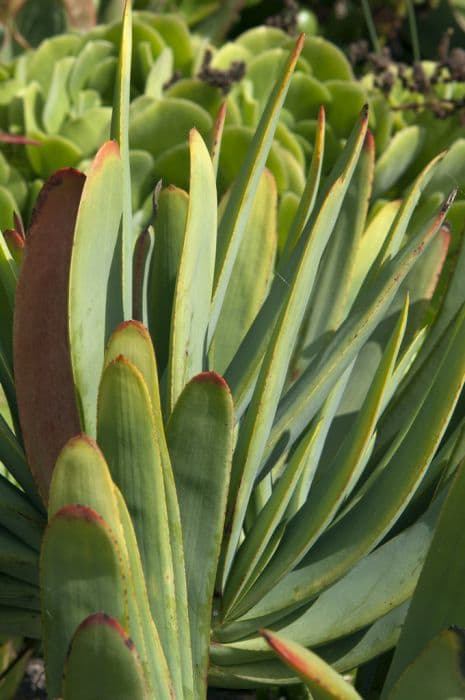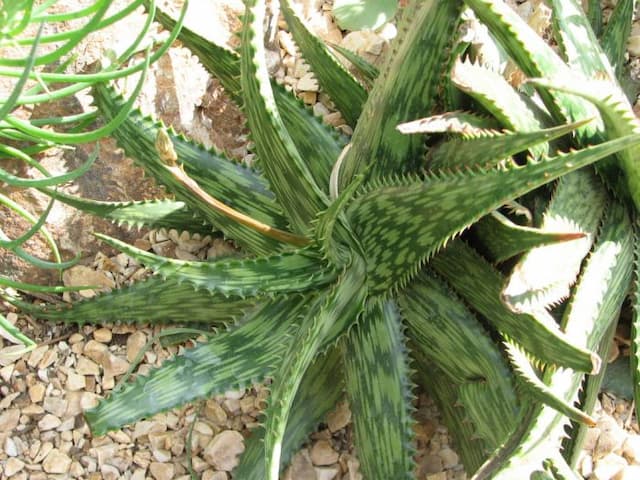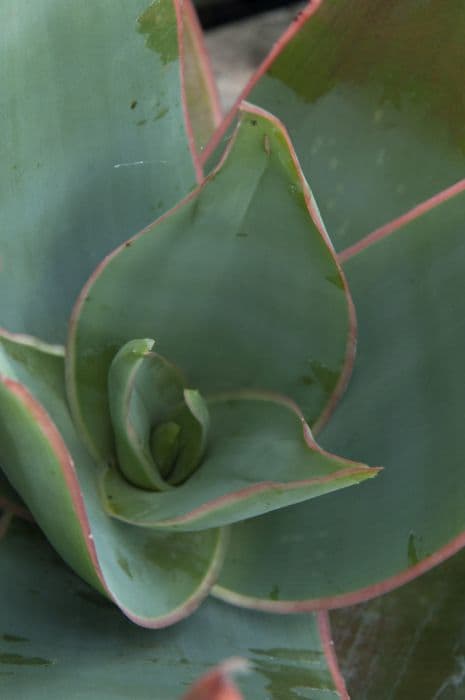Tiger Aloe Aloe variegata (v)

ABOUT
Aloe variegata, commonly known as Tiger Aloe, has a distinctive and striking appearance. The plant is made up of dense, compact rosettes of succulent leaves that are usually triangular and curve upwards. The leaves themselves possess a unique variety of colors, with a deep green base and lighter green or white variegations that resemble stripes or spots, giving it the appearance of tiger stripes. The variegation patterns are quite pronounced and make this plant easily recognizable. The surface of the leaves can be smooth or slightly bumpy, depending on the individual plant, and the edges of the leaves often have small teeth that can be sharp to the touch. In certain conditions, the leaf margins may take on a reddish or pinkish tinge, adding to the plant's ornamental appeal. When in bloom, Tiger Aloe produces tall flower spikes that rise from the center of the rosette. The flowers tend to be tubular and are usually a reddish-orange or yellow color, contrasting beautifully with the striking variegated foliage beneath. Overall, the plant's visual appeal lies in its richly patterned leaves and robust, sculptural form, making it a popular choice for indoor and outdoor plant enthusiasts seeking a small but visually interesting succulent for their collection or garden landscapes.
About this plant
 Names
NamesSynonyms
Partridge-breasted Aloe, Tiger Aloe, Lace Aloe, Goats-foot.
Common names
Aloe variegata, Aloe perfoliata var. variegata, Gonialoe variegata.
 Toxicity
ToxicityTo humans
Tiger Aloe (Aloe variegata) is generally not considered toxic to humans. However, it does contain saponins and anthraquinones, which can have laxative effects if ingested. Accidental ingestion can lead to gastrointestinal symptoms such as diarrhea, cramps, or nausea. In general, it is advised to avoid eating this or any other decorative plant to prevent any potential adverse effects.
To pets
Tiger Aloe is toxic to pets. If pets ingest this plant, they can experience symptoms such as vomiting, diarrhea, lethargy, depression, anorexia, tremors, and change in urine color. The toxic components, saponins and anthraquinones, can cause gastrointestinal upset and irritation. It is important to prevent pets from chewing on or ingesting the plant. If a pet does consume Tiger Aloe, contact a veterinarian as soon as possible.
 Characteristics
CharacteristicsLife cycle
Perennials
Foliage type
Evergreen
Color of leaves
Variegated
Flower color
Red
Height
1-2 feet (30-60 cm)
Spread
1-2 feet (30-60 cm)
Plant type
Succulent
Hardiness zones
9
Native area
South Africa
Benefits
 General Benefits
General Benefits- Drought Tolerance: Aloe variegata, commonly known as Tiger Aloe, is well-suited for xeriscaping and low-water gardens due to its ability to tolerate prolonged periods of drought.
- Ornamental Appeal: With its striking variegated leaves and unique growth pattern, Tiger Aloe adds visual interest to any landscape or indoor environment.
- Easy Maintenance: Requiring minimal care, Tiger Aloe is an ideal plant for those with busy lifestyles or for someone new to gardening.
- Container Gardening: Tiger Aloe is well-suited for pots and containers, making it a versatile option for balconies, patios, or indoor spaces with limited room.
 Medical Properties
Medical PropertiesThis plant is not used for medical purposes.
 Air-purifying Qualities
Air-purifying QualitiesThis plant is not specifically known for air purifying qualities.
 Other Uses
Other Uses- Aloe variegata, commonly known as Tiger Aloe, can be used as a natural insect repellent due to its bitter sap which is unappealing to many insects.
- The gel-like substance inside Tiger Aloe leaves can be used as a natural hair conditioner, providing moisture without the use of chemicals.
- Dried Tiger Aloe leaves have been used in crafting, to create unique textures and patterns in papermaking and other fibrous art forms.
- The distinctive stripes of Tiger Aloe can inspire artists and designers for pattern design, where the leaf patterns are mimicked in fabrics or wallpaper.
- When planted in outdoor gardens, Tiger Aloe can serve as a natural barrier to small animals because of its spiky edges and robust leaves.
- Tiger Aloe can be used in educational settings for lessons on drought-resistant plants and desert ecosystems due to its native habitat and adaptations.
- The plant's robust leaves can be used as bookmarks; once dried, they maintain their shape well and can provide a natural, biodegradable alternative to paper or plastic markers.
- In some cultures, Tiger Aloe plants are given as gifts symbolizing good luck and protection against negative energy due to their hardy nature and long lifespan.
- Hobbyists may use the sap from the Tiger Aloe to create natural dyes for fabric, offering a sustainable source for coloring textiles.
- During festive seasons, Tiger Aloe can be part of a themed decoration, especially for those looking for a more sustainable and live option compared to cut flowers.
Interesting Facts
 Feng Shui
Feng ShuiThe Tiger Aloe is not used in Feng Shui practice.
 Zodiac Sign Compitability
Zodiac Sign CompitabilityThe Tiger Aloe is not used in astrology practice.
 Plant Symbolism
Plant Symbolism- Healing: Aloe variegata, also known as Tiger Aloe, symbolizes healing due to its medicinal properties, particularly in soothing skin irritations and burns.
- Protection: Tiger Aloe is thought to offer protection against negative influences and bad luck, often used in rituals for this purpose.
- Endurance and Persistence: The plant is resilient and can survive in harsh conditions, symbolizing the ability to endure challenging circumstances.
- Beauty: Its distinctive striped leaves bring to mind the beauty of uniqueness and the appreciation of natural aesthetics.
 Water
WaterPartridge-breasted Aloe requires infrequent watering, about once every two to three weeks. It is best to allow the soil to dry out completely between waterings. When you do water, provide enough to thoroughly soak the soil. Depending on pot size, use approximately 8-16 ounces of water. During the winter months, reduce watering to once a month or less, as the plant goes into dormancy.
 Light
LightPartridge-breasted Aloe thrives in bright, indirect sunlight but can also tolerate some direct sun. The ideal spot would be in a room with a south or west-facing window where it can receive a few hours of direct sunlight, particularly in the morning, with filtered light throughout the rest of the day.
 Temperature
TemperaturePartridge-breasted Aloe prefers a warm climate with temperatures ranging between 60 and 75 degrees Fahrenheit. It can survive temperatures as low as 40 degrees Fahrenheit but should not be exposed to frost, which could damage the plant. The ideal temperature for robust growth is within the 70s Fahrenheit.
 Pruning
PruningPartridge-breasted Aloe generally does not require extensive pruning. Dead or damaged leaves can be removed to improve appearance and encourage healthy growth. Pruning is best done in the spring or early summer, removing leaves from the base and any flower stalks after blooms have faded.
 Cleaning
CleaningAs needed
 Soil
SoilPartridge Breast Aloe thrives in a well-draining soil mix, typically composed of two parts sand or gravel, one part perlite or pumice, and one part organic matter, such as potting soil or coconut coir. A slightly acidic to neutral pH range of 6.0 to 7.5 is ideal for this succulent.
 Repotting
RepottingPartridge Breast Aloe should be repotted every two to three years to refresh the soil and accommodate root growth. It is best to repot in the spring or early summer.
 Humidity & Misting
Humidity & MistingPartridge Breast Aloe prefers dry air and is tolerant of low humidity levels, making it well-suited for typical indoor environments.
 Suitable locations
Suitable locationsIndoor
Place in bright, indirect light and avoid overwatering.
Outdoor
Full to partial sun; protect from frost and excessive rain.
Hardiness zone
9-11 USDA
 Life cycle
Life cycleAloe variegata, commonly known as the Tiger Aloe, begins its life cycle as a seed, typically germinating in warm conditions with minimal water. The seedlings emerge and transform into juvenile plants developing thick, fleshy leaves arranged in a rosette pattern, characteristic of Aloe species. As the plant matures, it undergoes vegetative growth, where it stores water and nutrients within its leaves to survive in arid environments. Tiger Aloe may produce offsets, or "pups," from the base, allowing vegetative propagation and the spread of the plant. After several years, mature Tiger Aloes produce tall flower spikes in late winter to spring, bearing tubular, orange to red flowers that attract pollinators such as bees and birds. Following pollination, seeds are formed and dispersed, completing the life cycle and allowing new plants to begin the process anew.
 Propogation
PropogationPropogation time
Spring-Summer
The most popular method of propagating Tiger Aloe (Aloe variegata) is through offset division. Typically, the best time to propagate Tiger Aloe by offsets is in the spring or early summer, when the plant is actively growing. Offsets, also known as pups, are small replicas of the parent plant that grow from the base. When the offset has developed its own roots and reached a reasonable size, usually a few inches in diameter, it's carefully detached from the mother plant with a clean, sharp knife. After removal, allow the offset to dry for a day or two, letting the cut site callous over, which prevents rot. The offset is then planted in a well-draining cactus or succulent soil mix and watered lightly to encourage root development. It's important to keep the soil slightly moist but never soggy until the offset is well established, which can be indicated by new growth.









